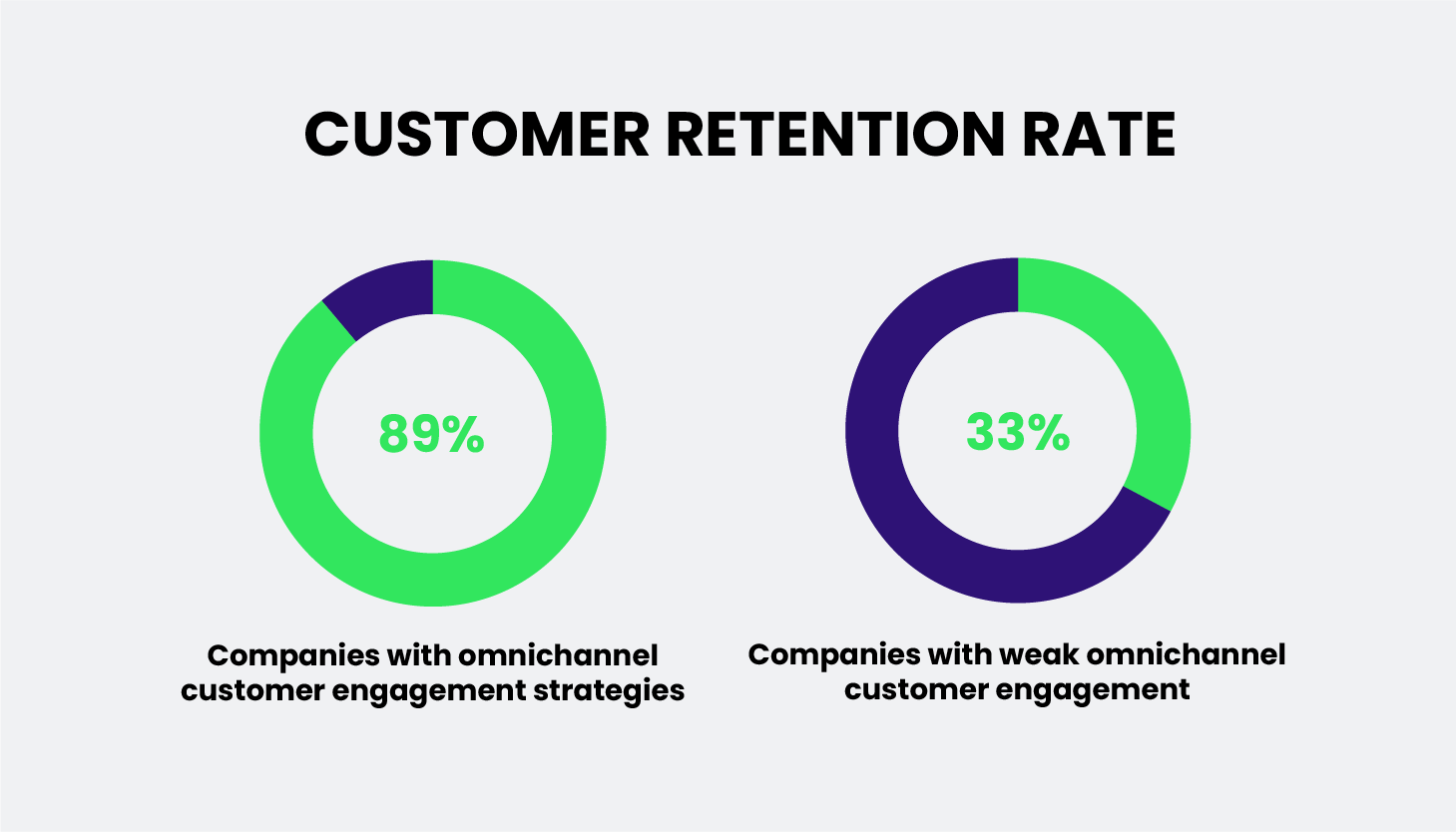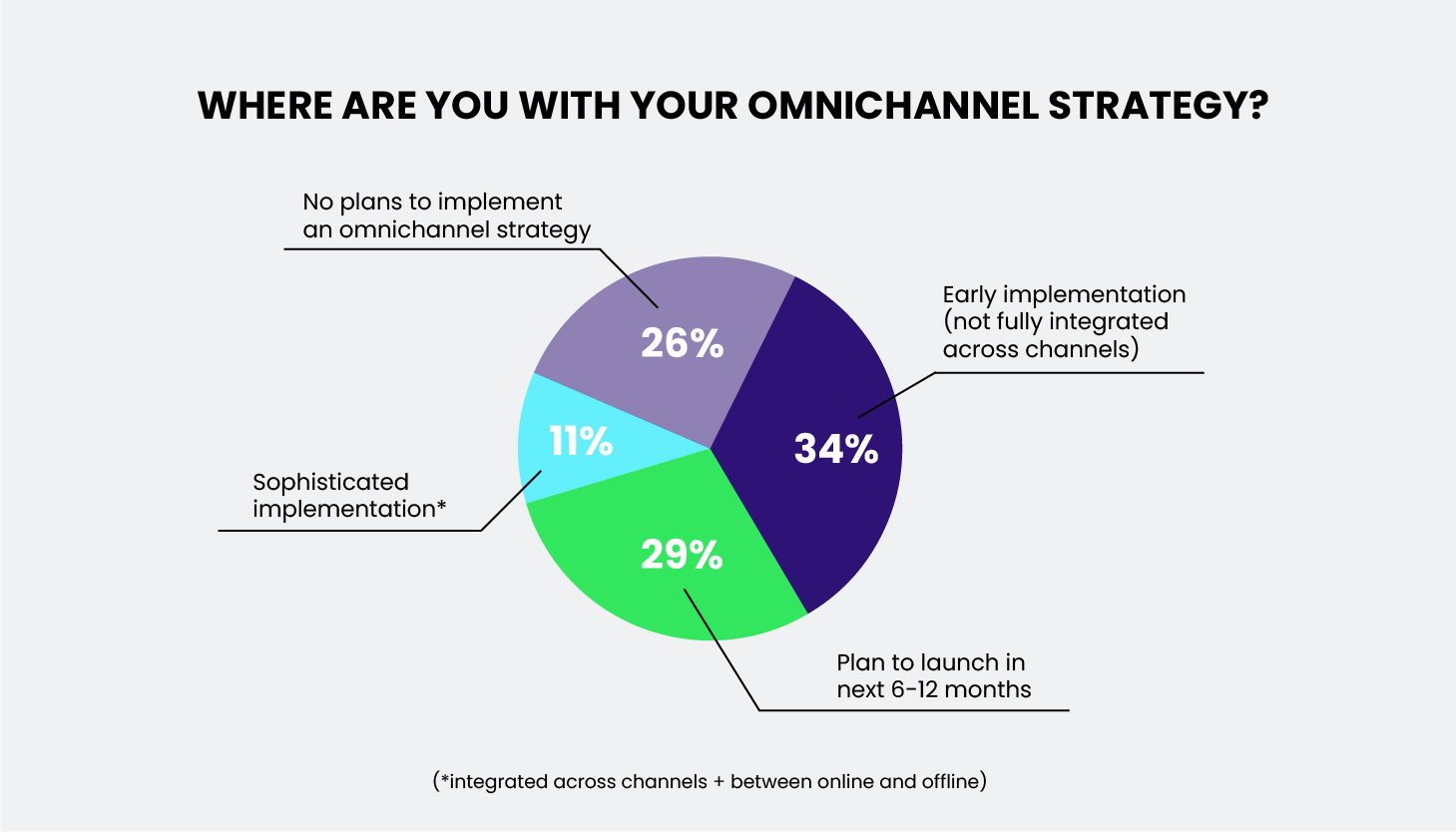28 Omnichannel Statistics Every Enterprise Needs to Know for 2024
Did you know that, on average, companies with omnichannel customer engagement strategies retain 89% of their customers?
Compared to a 33% customer retention rate for companies with weak omnichannel strategies.
Whilst the idea of an omnichannel strategy may have been a 'nice to have' in the past, the covid pandemic forced brands to acknowledge their omnichannel strategies or risk losing out to the competition.
This is because consumers went online, and the brands that succeeded the most were the ones who engaged their customers online and provided the best omnichannel experience.
Why should brands invest in omnichannel?
Before the covid pandemic, customers were shopping across multiple channels and devices.
More and more were searching online and then proceeding to the store to purchase.
Research collected by Think With Google indicated that omnichannel strategies help generate around 80% of the in-store visits by customers. Furthermore, as much as 74% of customers do online research before actually visiting a physical store.
Because here’s the thing: According to data, 55% of consumers still enjoy going to physical stores to touch and see products. Even if they end up buying online, their in-store experiences often affect their decisions.
Even customer orders made online and collected at stores grew 208% during the pandemic. That's because 67% of shoppers now expect to purchase online and then proceed to pick it up from the store.
Alternatively, customers may be at a physical shop, select an item they like but there is not the correct size, dimensions, or color, and then pull out a smart device to check online for it and buy it there. 77% of shoppers who use their smartphones for inventory research within a shop state that it has become an essential part of the experience.
It's evident then that an essential aspect of omnichannel is that each channel is interconnected to provide a consistent brand experience and connected purchase journey.
For instance, data from RetailMeNot concluded that 69% of consumers had used their mobile devices to check products at home, with 53% having used their smartphones to check reviews before chatting to a store employee.
By the year 2024, it is anticipated that mobile commerce (“mcommerce”) will constitute 40.4% of total ecommerce sales.
And by 2025, mobile sales are projected to account for 10.4% of all retail transactions.
In omnichannel marketing, a brand will use several channels to reach a customer, but each touchpoint is managed separately with a different strategy.
A customer-first omnichannel marketing strategy is centered around the customer and ensures that customers can quickly and effortlessly switch between each brand touchpoint to make a purchase.
Brands with a top omnichannel customer engagement see a 9.5% yearly increase in annual revenue, compared to 3.4% for poor omnichannel brand strategies.
Furthermore, according to research, solid omnichannel brands witness a 7.5% yearly decrease in cost per contact.
And yet, only 11% of organizations claim to have a sophisticated omnichannel implementation.
It's important to note that 77% of highly effective omnichannel businesses store customer data across various channels. This is in contrast to only 48% of less effective omnichannel companies.
Omnichannel strategies drive revenue growth
Fifteen years ago, the average consumer typically used only a couple of digital touchpoints when purchasing a product, and only 7% used more than four. Today customers use an average of almost six touchpoints, with 50% regularly using more than four.
It’s worth mentioning that by expanding to three or more channels, companies can boost their order rate by a substantial 494%.
For instance, U.S. retailer Target enjoyed its best quarterly results in 2020, with its sales increasing by 24.3% and digital sales soaring by 195%!
It won market share from all its physical competitor's thanks to the integration of physical and digital – the omnichannel.
Target discovered that multichannel customers spend 4 times as much as in-store customers and 10 times more than digital-only customers. Through that quarterly period, their stores fulfilled more than three-quarters of their online sales.
Marketers have learned that using three or more channels in any campaign can earn a 287% higher purchase rate than using a single-channel campaign. Moreover, customer purchase frequency is 250% higher on omnichannel than on a single channel, and even the size of average orders increased by 13%.
Even more interesting is that omnichannel consumers have a 30% higher lifetime value to brands than those who purchase using only one channel.
The shift from single channel to omnichannel
Modern customers want to shop most conveniently, they are unwilling to accept anything less than the best interactions with a brand.
Nevertheless, their needs are increasingly not being met on their terms. It is time for brands to make the leap to meet consumer expectations better and engage them across every touchpoint, both physical and digital.
Recent research revealed that two-thirds of customers are not likely to buy from a brand that does not offer an integrated omnichannel experience.
Moreover, 59% said they would buy from a competitor offering a better shopping experience.
Plus, when customers have had several bad experiences, about 80% of them would rather choose a different company to buy from instead of sticking with the same one.
> Today's consumers want to be valued across every interaction with a brand. For instance, 98% of Americans switch between devices on the same day and expect the same experience from the brand each time.
> Consumers expect the same expertise and service across every channel — and they will not hesitate to shop elsewhere if they feel like they do not matter enough. 27% of customers would leave and visit another brand's store if an item is out of stock, with 21% stating they would instead purchase online from different competitors, and 21% would hold off buying the product.
All of this adds up:
While omnichannel customers represent only 7% of all customers, they generate 27% of all sales!
And it is not only marketers who must deliver an omnichannel strategy.
Customer service and sales reps are also as important to consumers with their interactions.
It’s worth noting that 89% of customers feel annoyed when they have to explain their problems to multiple customer service representatives.
Plus, when customers have a good experience with customer service, 89% of them are more inclined to buy from the same company again.
Over 35% of customers expect to contact the same customer service representative through any channel. In comparison, 45% of shoppers in-store expect sales associates to be knowledgeable about online-only products.
So it is time for brands to consider potential customers as their customers — not only in-store or online, but as customers all the time, everywhere they are.
The year omnichannel marketing goes mainstream
Omnichannel branding is here to stay, and customers are increasingly opting to shop with retailers that offer interchangeable shopping experiences across different media.
With today's enterprise tools and technology, enterprises of all sizes can implement omnichannel strategies in their businesses.
An omnichannel strategy aims to optimize the customer journey, understanding their habits, behavior and interests, and the content they consume.
Plus, brands with a strong omnichannel presence can store customer data across channels, representing a treasure trove of data that brands can use to facilitate better customer experiences.
Brands must create marketing content customers demand and deliver it to them in a format, channel, and on any device they prefer, creating consistent global messaging.
Leveraging DAM technology for omnichannel success
So far, so good.
Except that 64% of marketers cite a lack of resources as their top barrier to omnichannel marketing. It's why enterprises invest in DAM software to ensure every marketer has the tools, resources, and means to create a superior omnichannel strategy.
A DAM platform ties it all together and gives brands the benefits shared drives fail to deliver.
A DAM controls all brand content from one place. With all users having access to a single source, it has never been easier for content to be delivered on all channels simultaneously.
By using DAM technology and the available functionalities, brands can automate marketing processes and take an omnichannel approach to the next level. It becomes easier for businesses, but best of all, it benefits your customers, too.
Want to learn more about how Digizuite can deliver a better omnichannel experience to your customers? Book a call with us today





